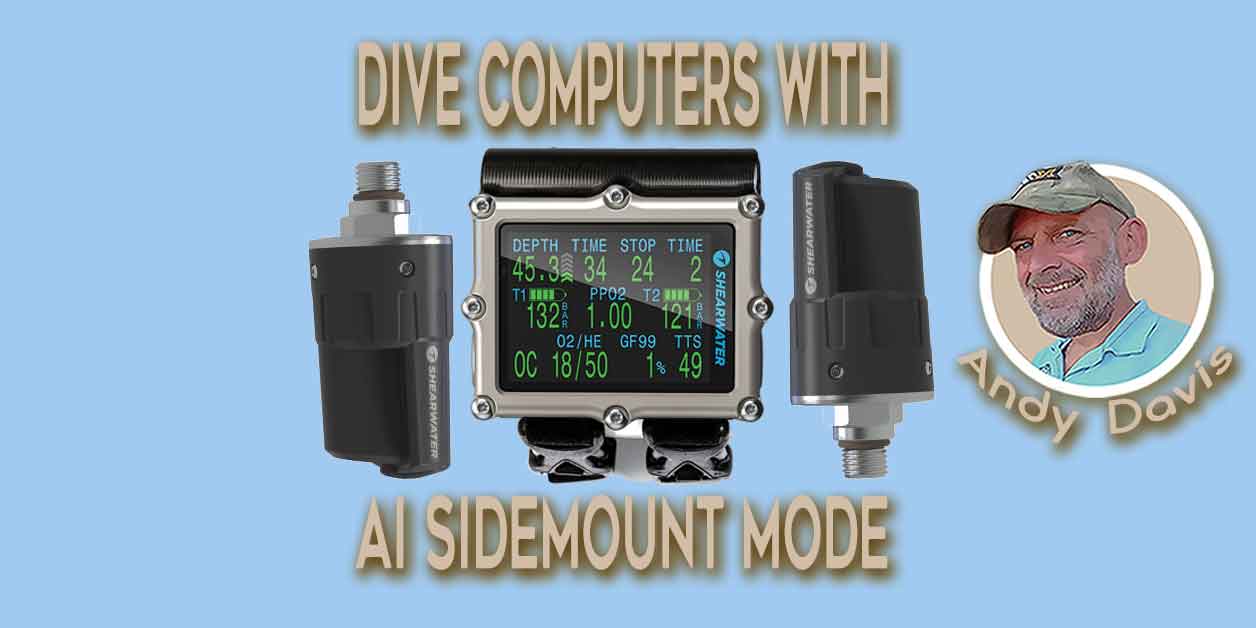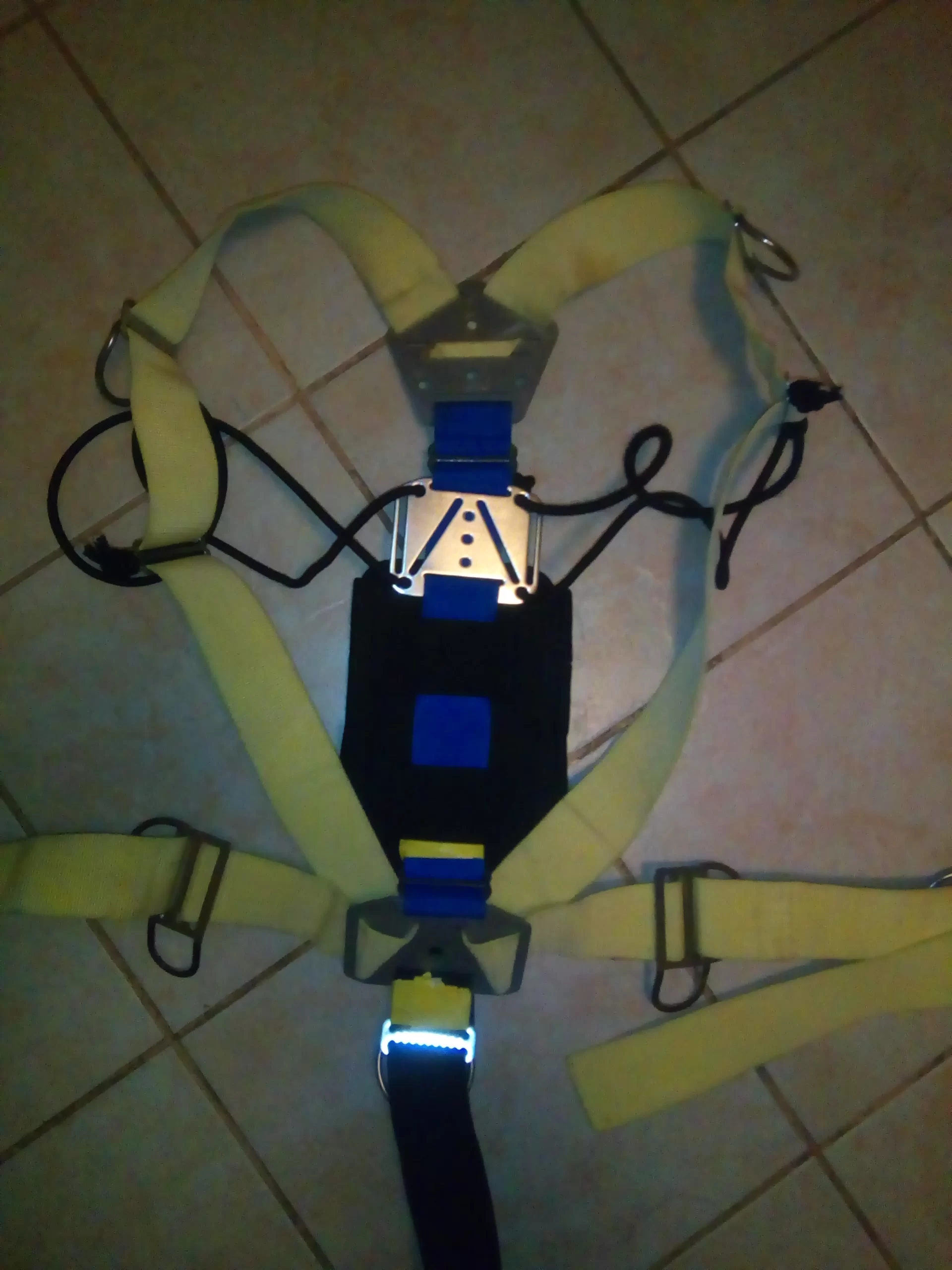Ultimate Guide to Sidemount Air Integration Setup
Are you a qualified sidemount diver looking to upgrade your gear? If so, you may be considering setting up your sidemount gear for air integration (AI). Sidemount air integration is becoming increasingly popular, and many diving computer manufacturers now produce sidemount AI models that can simultaneously track the contents of two cylinders.
However, setting up sidemount air integration can be problematic, and it is easy to clutter your regulator configuration unnecessarily. In this article, I will guide you through the process of setting up your sidemount gear air integration optimally, so you can experience the benefits without any hassle.
The pros and cons of sidemount air integration
Sidemount air integration has become increasingly popular among divers who want easy access to monitor their gas supply directly from their dive computer. However, as with any gear modification, there are both pros and cons to consider.
The pros of sidemount air integration
On the one hand, sidemount air integration can offer:
- Air integration allows the diver to easily read a digital display of their cylinder contents.
- AI is especially useful for divers who have vision problems reading analog gauges.
- More convenient monitoring increases situational awareness.
- Air integration can provide more accurate gas supply awareness
- AI eliminates the need to perform real-time gas management during dives.
The cons of sidemount air integration
On the other hand, setting up sidemount air integration on a sidemount configuration can cause problems:
- Sidemount regulator first-stages are positioned under the armpits, making it difficult to position transmitters in a secure, unintrusive, and comfortable location.
- Air integration transmitters require batteries and need to remain wirelessly connected to your dive computer. They may be subject to malfunctions or failure.
- Delegating real-time gas management to your dive computer prevents you from developing this into an unconscious skill.
- Sidemount air integration adds considerable expense to your diving setup.
The first step is to consider whether sidemount air integration is the best choice for you. It is wrong to automatically assume that it must be an improvement to your diving configuration.
Understanding the pros and cons of sidemount air integration can help divers make informed decisions about their sidemount setup and ensure they don’t make costly mistakes.
Factors to consider before choosing air integration
If you’re considering using air integration with your sidemount diving setup, there are a few factors to take into account. While air integration can offer several benefits, it also has some drawbacks that may not make it the best choice for every diver. Here are some key factors to consider before choosing sidemount air integration:
- Diving goals: Consider your diving goals and objectives. Are you primarily interested in recreational diving or do you plan to take on more challenging technical dives? Air integration can be a useful convenience for recreational divers, but it remains generally frowned upon for technical diving.
- Diving conditions: Think about the type of diving you plan to do and the conditions you’ll encounter. For example, if you’re diving in silty overhead environments, you may value having your gas supply information illuminated brightly as part of your dive computer display.
- Gear configuration: Consider the configuration of your sidemount gear and how air integration will fit in. With regulators mounted under the armpits, air integration adds extra hoses and o-ring connections that make your setup more convoluted and increase the number of potential points of failure.
- Budget: Air-integrated transmitters are expensive, so it’s important to consider your budget and whether the additional cost is worth the benefits.
Sidemount air integration with or without a backup SPG?
Sidemount divers have a variety of options when it comes to air integration, including whether or not to use a backup submersible pressure gauge (SPG). The decision to use a backup SPG will depend on individual preferences and comfort level.
Some divers prefer the added security of having a backup SPG in case of a malfunction with the sidemount air integration transmitters. Others may find the additional gauge cumbersome and opt to rely solely on the air-integrated computer.
It is important to consider factors such as:
- The type of diving planned
- Personal diving experience and ability
- The potential consequences of losing gas supply information
- The risk severity of regulator system failures
Adding backup SPGs further complicates your sidemount setup and adds additional failure points. In some circumstances, those risks can outweigh the benefit of having backup gas supply information.
For instance, on a recreational sidemount dive, you have a redundant gas system with ample gas volume. A transmitter failure should not put you in jeopardy because you always have the option to abort the dive and ascend. In that case, you can be confident of having enough gas to safely reach the surface.
On the other hand, a high-pressure o-ring failure during a technical or cave dive would deplete your overall gas supply. In turn, that may constitute a life-threatening emergency.
Ultimately, the choice will come down to individual preferences, the level of redundancy, and the limitation of failure points desired in your sidemount setup.
Sidemount air integration without backup SPGs
Configuring sidemount air integration without a backup SPG is quite straightforward. However, it is not as simple as just screwing the transmitter into your regulator first stage high-pressure (HP) port.
The wrong way to configure sidemount AI transmitters
A common mistake when configuring sidemount air integration without backup SPGs is to attach the transmitter directly to the regulator first stage.
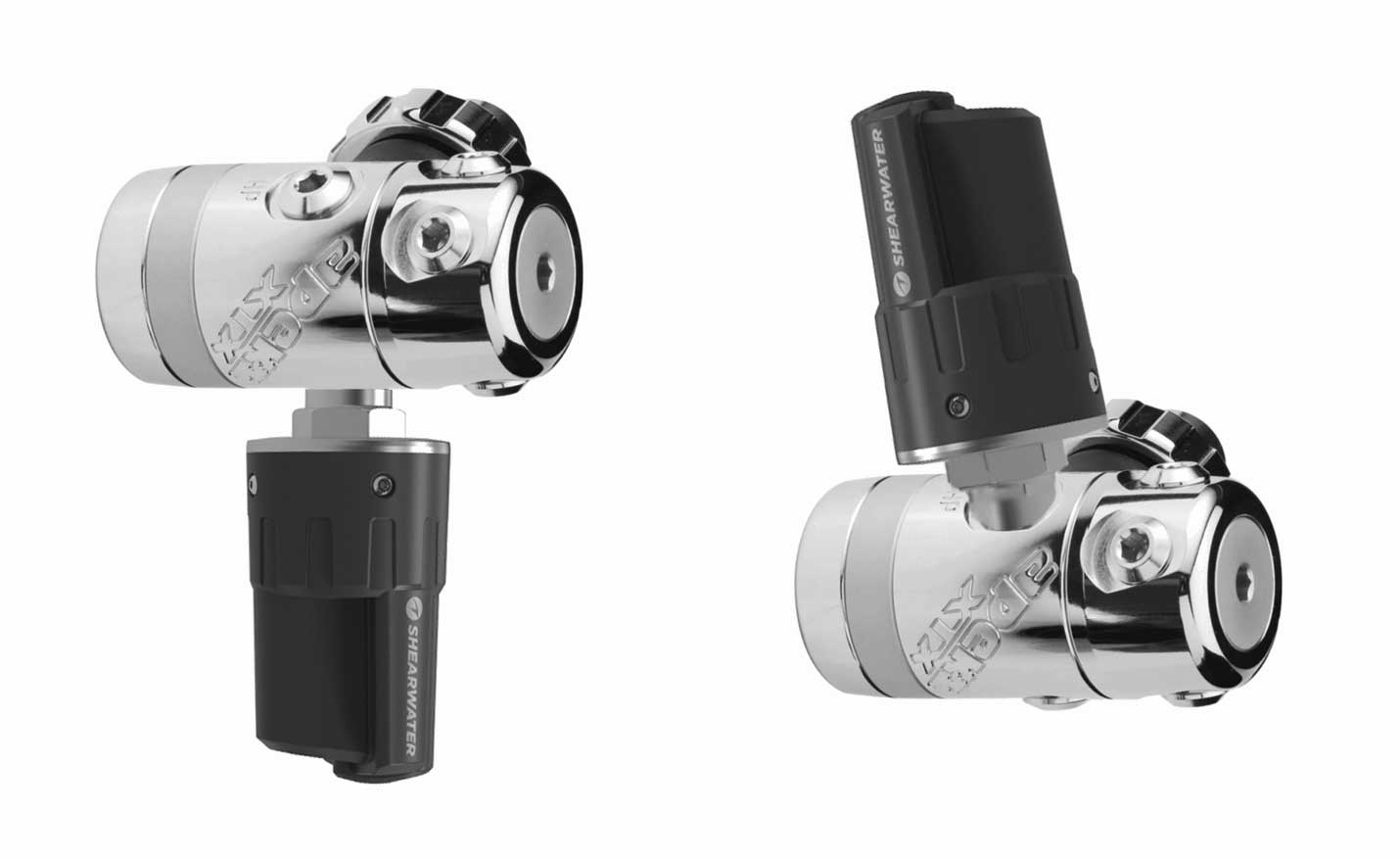
Direct connection of the AI transmitter to the regulator is not recommended* for the following reasons:
- It is inflexible which leaves the transmitter prone to being damaged by any impacts.
- The transmitter protrudes in a critical area that:
- Prevents the first stage sitting ideally under the armpit to enable correct cylinder trim.
- Poses a risk of entanglement with the sidemount bungees.
- May be uncomfortable against your armpit.
*However, it should be noted that some high-level cave divers do opt for direct connection of the AI transmitter to the regulator first stage. Some specialist types of diving have unique demands. In this specific case, the risk of entanglement may be deemed to exceed that of transmitter or regulator damage from a collision.
Risk assessments should always be specific to the nature of the dives undertaken.
The right way to configure sidemount AI transmitters
Adding a 6-9″ high-pressure (HP) hose between the regulator first-stage and the AI transmitter solves those problems.
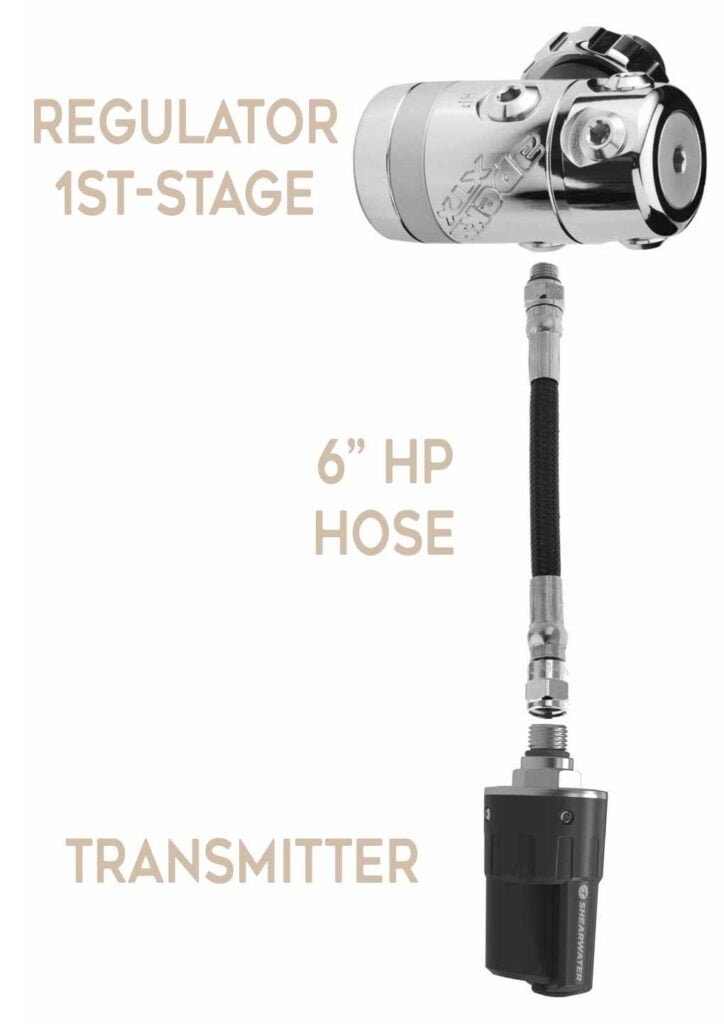
This configuration allows the transmitter to lay flat along the inside of the cylinder where it is protected against damage. The hose enables the transmitter to move if it is snagged or banged; which prevents it from being snapped at the connection point. Additionally, the transmitter is no longer obtrusive and uncomfortable in the armpit area.
Sidemount air integration with backup SPGs
If you opt to include backup SPGs for your sidemount air integration, there are several options to consider and some factors to understand.
1. Sidemount AI with a mini button gauge SPG
A button gauge SPG, also known as a mini SPG, is a compact submersible pressure gauge that can be attached to a diving regulator. They are a tempting choice when the sidemount diver hopes to keep their regulator setup as clean and streamlined as possible.
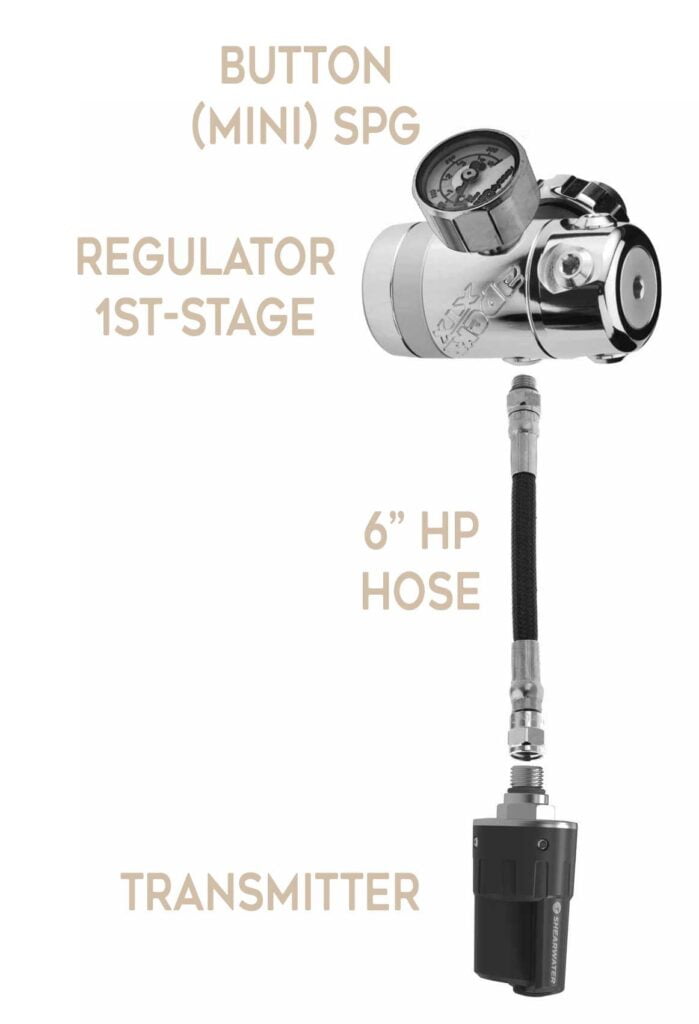
Here are some pros and cons of using a mini button gauge SPG for a diving regulator:
Mini button gauge SPG pros:
- Compact Size: Mini SPGs are far smaller than traditional SPG, making it less obtrusive on sidemount regulators.
- Cheap: Button gauge SPGs are much cheaper than proper SPGs.
Mini button gauge SPG cons:
- Inaccurate: The small size of Mini SPGs means that gas supply information is vague and imprecise. It is only sufficient for checking approximate cylinder contents, not for detailed real-time gas management.
- Failure prone: Button SPGs fail far more frequently than full-size SPGs. These can include the gauge face popping off, and leading to gas loss.
- Less durable: Mini SPGs are far less rugged than full-sized SPGs. As a consequence, they are easily damaged by impacts.
I advise against using mini button SPGs
Overall, I advise against using mini button gauge SPGs on sidemount systems. The significant drawbacks do not compensate adequately for a cheaper price and the convenience of setup.
If you need backup gas information in the event of a transmitter failure, then a button gauge is insufficient. If you don’t need that detailed real-time gas supply information, don’t use a backup SPG at all.
Similarly, if a button gauge physically fails during a dive, you may experience gas supply depletion. Regulators are life-support equipment and you should not compromise your safety for the sake of cheapness and convenience. If you need to back up your AI transmitters, do it with a proper SPG.
2. Sidemount AI with a full-sized SPG
Similarly to configuring a regulator without a backup SPG, some sidemount divers make the mistake of attaching the AI transmitter directly to the regulator first stage. This is often because they see no solution for the first stage only having two HP ports.
Sidemount AI with an SPG the wrong way
Attaching the AI transmitter directly to the top of the regulator first stage causes all of the drawbacks I have previously described. As a result, this configuration should be avoided.
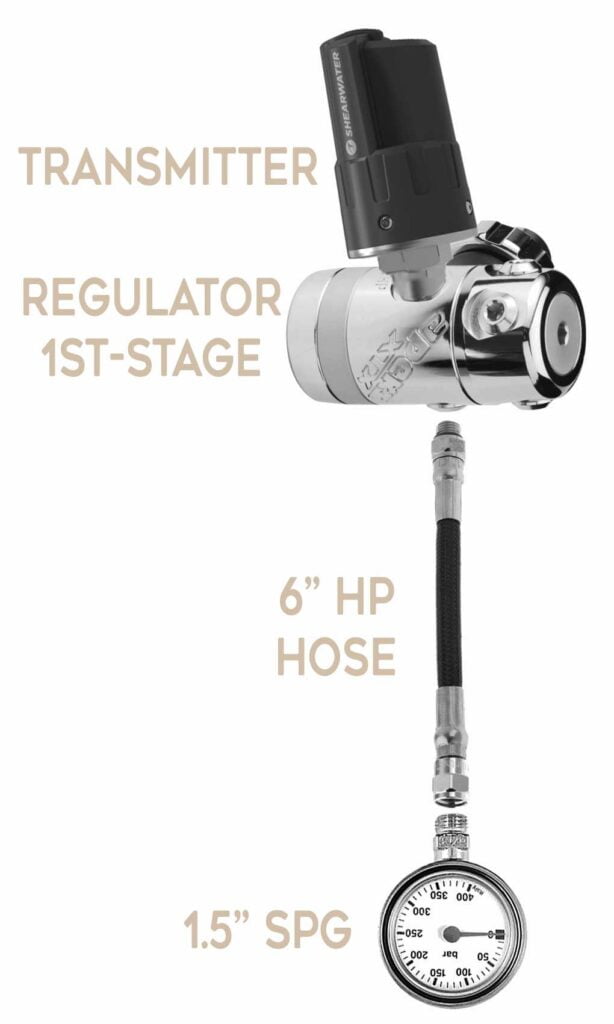
The solution for configuring sidemount AI with a full-sized SPG
The best way to set up sidemount air integration for a streamlined and efficient configuration necessitates routing both the AI transmitter and SPG downwards from the regulator’s first stage.
Use an HP splitter
The way to achieve downward routing of the AI transmitter and backup SPG is to incorporate an HP splitter, also known as an Apeks twin adaptor.
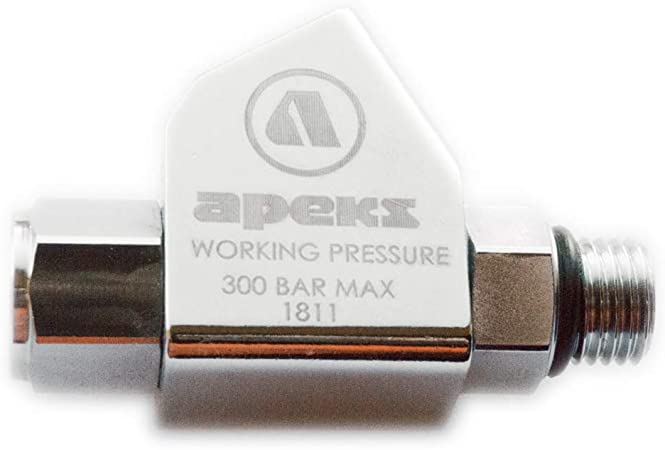
The HP splitter screws into the downwards facing HP port on your regulator’s first stage and allows two HP connections: one for your AI transmitter and one for your backup SPG.
The ideal sidemount air integration setup
Using the HP splitter, attach both the AI transmitter and backup SPG using 6″ HP hoses. As a result, both components will be in an unobtrusive and well-protected location. Additionally, you will still be able to easily access and read the SPG.
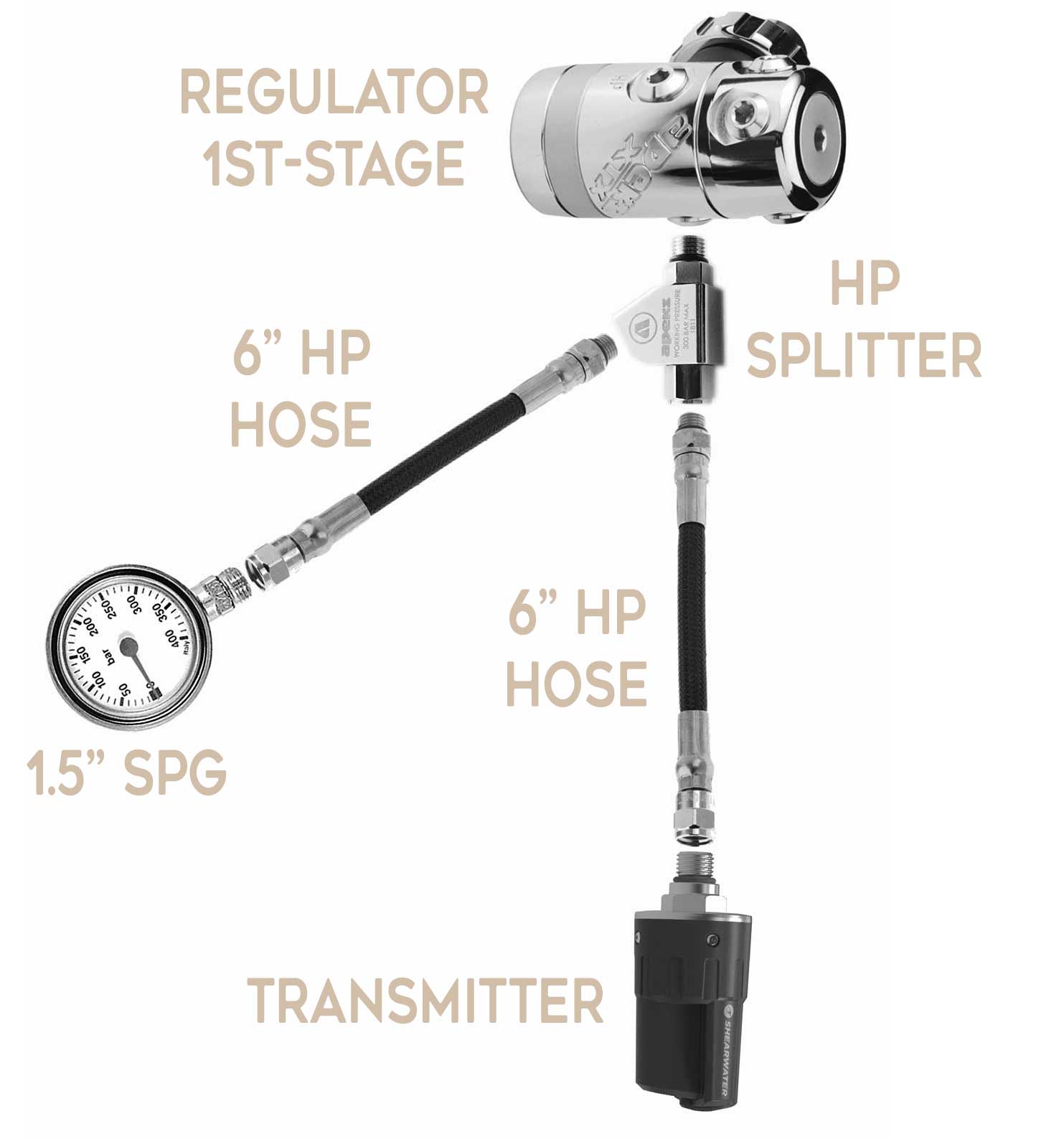
This solution offers the best streamlining, in-water functionality, and effectively protects your regulator components.
Dive computers that offer sidemount air integration
If you are considering adding air integration to your sidemount configuration you will need a dive computer that offers a sidemount AI mode. This mode simultaneously displays gas information for both primary sidemount cylinders on the main screen.
This differs from diving computers that simply allow multiple transmitters to be connected, but do not display two cylinders simultaneously on their screen. AI Sidemount mode means you do not need to constantly change your active transmitter whenever you swap between regulators.
If you haven’t yet bought an air-integrated diving computer, the following manufacturers offer dedicated AI sidemount mode functionality:
For more details and specifications on these air-integrated computers with ai sidemount function, please see my review:
Buy my ‘Sidemount: Principles For Success’ ebook now!

My comprehensive guide to sidemount configuration and development as a diver.
178 Pages. PDF format. Only $25
Fully Illustrated!
Chapters include:
- Sidemount history, design styles, and cylinder principles
- Harness and bungee setup and sizing
- Configuring deco/stage cylinders
- Diagnosing cylinder trim problems
- Regulators and hardware
- Training and skillset development
About The Author

Andy Davis is a RAID, PADI TecRec, ANDI, BSAC, and SSI-qualified independent technical diving instructor who specializes in teaching sidemount, trimix, and advanced wreck diving courses.
Currently residing in Subic Bay, Philippines; he has amassed more than 10,000 open-circuit and CCR dives over three decades of challenging diving across the globe.
Andy has published numerous diving magazine articles and designed advanced certification courses for several dive training agencies, He regularly tests and reviews new dive gear for scuba equipment manufacturers. Andy is currently writing a series of advanced diving books and creating a range of tech diving clothing and accessories.
Prior to becoming a professional technical diving educator in 2006, Andy was a commissioned officer in the Royal Air Force and has served in Iraq, Afghanistan, Belize, and Cyprus.
In 2023, Andy was named in the “Who’s Who of Sidemount” list by GUE InDepth Magazine.
Purchase my exclusive diving ebooks!
Sidemount air integration FAQ
Yes, AI dive computers can be used with sidemount configuration. It is best to use a computer with dedicated AI sidemount mode for simultaneous cylinder monitoring.
The Shearwater Perdix 2 Ti, Shearwater Petrel 3, Ratio iDive Color, Ratio iXM3-2, and the Apeks DSX have a dedicated sidemount mode.
Use an HP splitter, also known as a twin adaptor, to route the AI transmitter and backup SPG downwards from the regulator’s first stage.
Air integration (AI) monitors your cylinder pressure during dives. It provides information about your gas consumption rate and the duration of the remaining gas.
AI dive computers perform gas management for the diver. That skill can be learned, but some divers prefer convenience over cost. AI is also beneficial for divers with bad eyesight who struggle to read analog SPGs.
Air integration (AI) does your gas management for you. It also improves situational awareness and makes gas monitoring easier. However, those skills can also be learned and applied by the diver. Basically, AI offers convenience at a higher cost.
Originally posted 2023-04-06 17:05:14.








